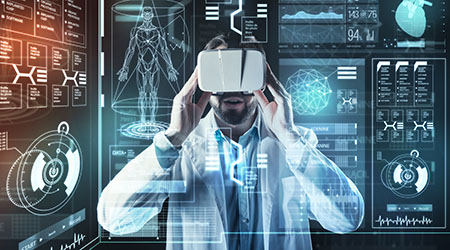The global virtual reality (VR) healthcare market size was $1.56 billion in 2018 and could reach $30.4 billion by 2026, with a CAGR of 42.4 percent, according to Fortune Business Insights. VR in healthcare falls into many categories, including pain management, education, training, rehabilitation, surgery and communication.
VR is useful for the rehabilitation of patients with severe pain. This includes those who are recovering from skin graft surgery, those who are healing from burn wounds, and children who are receiving daily injections. Immersive VR can captivate and effectively distract the user, therefore relieving pain. It can be very helpful when the use of anesthesia or sedation is not advised.
Medical training of today involves the use of skills, strategy and hands-on learning to deal with any given situation. VR can be used in a variety of applications to help students get a real-world feel to their education. It gives them a detailed visual way to learn and execute common surgical procedures.
VR has been proven to shorten recovery times by making it easier for patients to complete their exercise programs. The stimulating digital experience takes the patient’s mind off of the pain while giving them motivation to complete their assigned activities.
VR is helpful in planning difficult surgical procedures beforehand. Its deeply engaging features can help a surgical team walk through an entire surgery while rehearsing the actions that need to be performed. So VR can minimize mistakes during a surgery. The technology can be useful for surgical robotics. The surgeon depends on the camera within the body to give an accurate view of the area being operated on. Mimicry of the tactile and sensory feedback needed during a surgery can also be performed by VR technology.
When dealing with communication, VR makes it easier for providers to share their knowledge with patients, and for patients to convey what they’re going through to providers without words. This allows for effective communication, improved understanding of ailments and of possible interventions.
VR is a continuously evolving technology and as it becomes more financially accessible it will be used at higher rates in medical applications. It likely will be used more to expand the possibilities of surgery and the healthcare domain as a whole.

 How Efficiency Checklists Help Hospitals Save Energy, Water and Money
How Efficiency Checklists Help Hospitals Save Energy, Water and Money Designing with Heart: Seen Health Center Blends Cultural Warmth and Clinical Care
Designing with Heart: Seen Health Center Blends Cultural Warmth and Clinical Care Rutgers Health and University Hospital Breaks Ground on Campus Expansion
Rutgers Health and University Hospital Breaks Ground on Campus Expansion What to Consider When Modernizing Healthcare Facilities
What to Consider When Modernizing Healthcare Facilities Corewell Health Beaumont Troy Hospital to Build New Tower
Corewell Health Beaumont Troy Hospital to Build New Tower